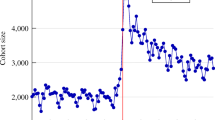Abstract
From 1969 through 1972, and therefore prior to Roe v. Wade, several states legalized abortion. I examine whether the liberalization of state abortion laws affects female labor force participation using data from the March Current Population Survey (CPS) and estimate several probit participation equations. Results indicate that abortion, by reducing unwanted pregnancies and hence fertility rates, has increased the labor force participation rates of females, especially of single black women.
Similar content being viewed by others
References
Angrist, Joshua D. and William N. Evans. “Schooling and Labor Market Consequences of the 1970 State Abortion Reforms.” In Solomon Polachek, ed. Research in Labor Economics, Vol. 18. Greenwich, Conn.: JAI Press, 1999, pp. 75–113.
Akerlof, George A., Janet L. Yellen, and Michael L. Katz. “An Analysis of Out-of-Wedlock Childbearing in the United States.” Quarterly Journal of Economics 111 (May 1996): 277–317.
Blau, Francine D. “Trends in the Well-Being of American Women, 1970-1995.” Journal of Economic Literature 36 (March 1998): 112–65.
Donohue, John J. and Steven D. Levitt. “The Impact of Legalized Abortion on Crime.” Quarterly Journal of Economics 116 (May 2001): 379–420.
Gray, Jeffrey S. “Divorce-Law Changes, Household Bargaining, and Married Women’s Labor Supply.” American Economic Review 88 (June 1998): 628–42.
Grossman, Michael and Theodore J. Joyce. “Unobservables, Pregnancy Resolutions, and Birth Weight Production Functions in New York City.” Journal of Political Economy 98 (Part 1, October 1990): 983–1007.
Gruber, Jonathan, Phillip B. Levine, and Douglas Staiger. “Legalized Abortion and Child Living Circumstances: Who Is the Marginal Child?” Quarterly Journal of Economics 114 (February 1999): 263–91.
Jensen, Gail A. and Michael A. Morrisey. “Mandated Benefit Laws and Employer-Sponsored Health Insurance.” Washington, D.C.: Health Insurance Association of America, January, 1999.
Joyce, Theodore J. “Did Legalized Abortion Lower Crime?“ NBER Working Paper No. 8319 (June 2001).
Levine, Phillip B., Douglas Staiger, Thomas J. Kane, and David J. Zimmerman. “Roe v. Wade and American Fertility.” American Journal of Public Health 89 (February 1999): 199–203.
Lott, John R., Jr. and John E. Whitley. “Abortion and Crime: Unwanted Children and Out-of-Wedlock Births.” Yale Law and Economics Research Paper No. 254 (April 2001).
Sklar, June and Beth Berkov. “Abortion, Illegitimacy, and the American Birth Rate.” Science 13 (September 1974): 909–15.
Author information
Authors and Affiliations
Rights and permissions
About this article
Cite this article
Kalist, D.E. Abortion and female labor force participation: Evidence prior to Roe v. Wade . J Labor Res 25, 503–514 (2004). https://doi.org/10.1007/s12122-004-1028-3
Issue Date:
DOI: https://doi.org/10.1007/s12122-004-1028-3




